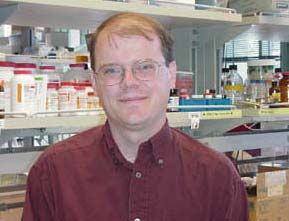UCSD Researchers ID Peptides That Bind to Alzheimer’s Plaques

Paul T. Martin, Ph.D. <br>
Two short protein segments, called peptides, have been identified by researchers at the University of California, San Diego (UCSD) School of Medicine, for their ability to recognize and bind to beta-amyloid-containing plaques that accumulate abnormally in the brains of Alzheimer’s disease patients, providing a possible “Trojan horse” mechanism to diagnose and treat the disorder.
“These peptide sequences are potential new tools for the delivery of medication to the amyloid plaques that are found in Alzheimer’s disease, or for new diagnostic tests that would allow early identification and treatment of the disease,” said the study’s senior author, Paul T. Martin, Ph.D., UCSD assistant professor of neurosciences.
In studies published in the September issue of the journal Neurobiology of Disease (published online Aug. 27, 2003), Martin and colleagues found that natural and synthetic versions of the peptides attach themselves to the abnormal plaque, while ignoring normal brain tissue.
Although past research has identified larger non-antibody and antibody proteins and small organic molecules that can bind to the amyloid plaques, the UCSD team said the newly discovered peptides may be a better choice for diagnosis and treatment. Smaller in size than previously identified proteins, the peptides may more easily cross the blood-brain barrier. In addition, some of the previously identified organic molecules could cause toxic side effects if given to people.
The scientists used a laboratory technique called phage peptide display to identify the two peptide sequences from a starting library of 50 million peptide sequences. These peptides were engineered to be exposed on the surface of bacteria by infecting the bacteria with bacteriophage (a bacterial virus). The peptide-expressing bacteria were then used to select for peptide sequences that bound amyloid plaques. An analysis of the bacteriophage showed that only the two peptides were able to seek out and bind to abnormal beta-amyloid.
“It is striking that we found only two peptide sequences, and that they were very similar in structure to one another,” Martin said. “This suggests that if other sequences do exist, they would most likely be variations on the structures we have already identified.”
He added that the UCSD team sees several potential applications for the peptides. First, they could be coupled to molecules designed to inhibit the toxicity of beta-amyloid plaques. The peptides might also be coupled to substances that stimulate the breakdown of plaques, or inhibit them from forming. A final application would be coupling the peptides to other markers that would highlight the abnormal plaque in imaging diagnostic tests. Currently, Alzheimer’s disease is diagnosed by cognitive tests involving patient interview, and a conclusive diagnosis requires postmortem analysis of the brain itself.
In addition to Martin, authors of the study included Christine Kang, staff research associate, and Vianney Jayasinha, an undergraduate student, in the UCSD Department of Neurosciences. The study was funded by the National Institutes of Health.
Contact:
Sue Pondrom
(619) 543-6163
spondrom@ucsd.edu
Media Contact
All latest news from the category: Health and Medicine
This subject area encompasses research and studies in the field of human medicine.
Among the wide-ranging list of topics covered here are anesthesiology, anatomy, surgery, human genetics, hygiene and environmental medicine, internal medicine, neurology, pharmacology, physiology, urology and dental medicine.
Newest articles

Breakthrough in magnetism that could transform quantum computing and superconductors
Researchers discover new magnetic and electronic properties in kagome magnet thin films. A discovery by Rice University physicists and collaborators is unlocking a new understanding of magnetism and electronic interactions…

NASA to launch innovative solar coronagraph to Space Station
NASA’s Coronal Diagnostic Experiment (CODEX) is ready to launch to the International Space Station to reveal new details about the solar wind including its origin and its evolution. Launching in…

Boosting efficiency in mining with AI and automation
“Doing instead of procrastinating”. This is the AI strategy presented by Prof. Constantin Haefner, Director of the Fraunhofer Institute for Laser Technology ILT, at the “AKL’24 – International Laser Technology…



